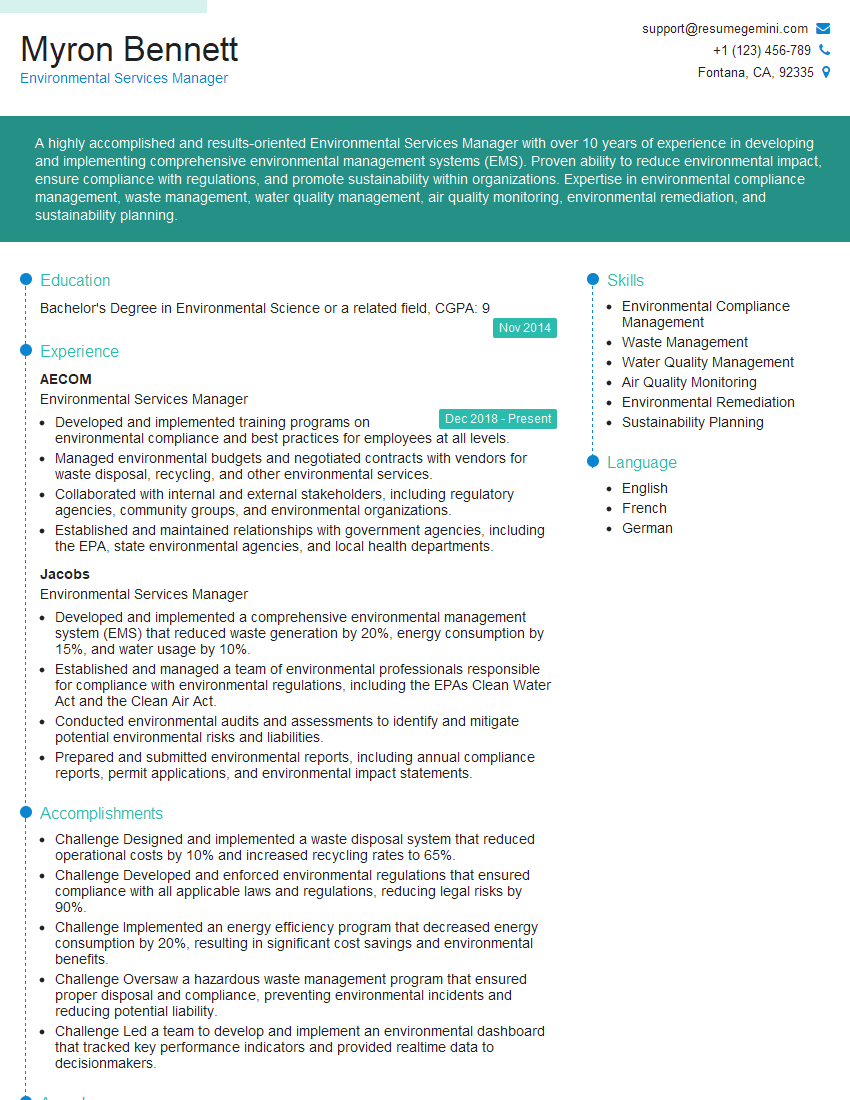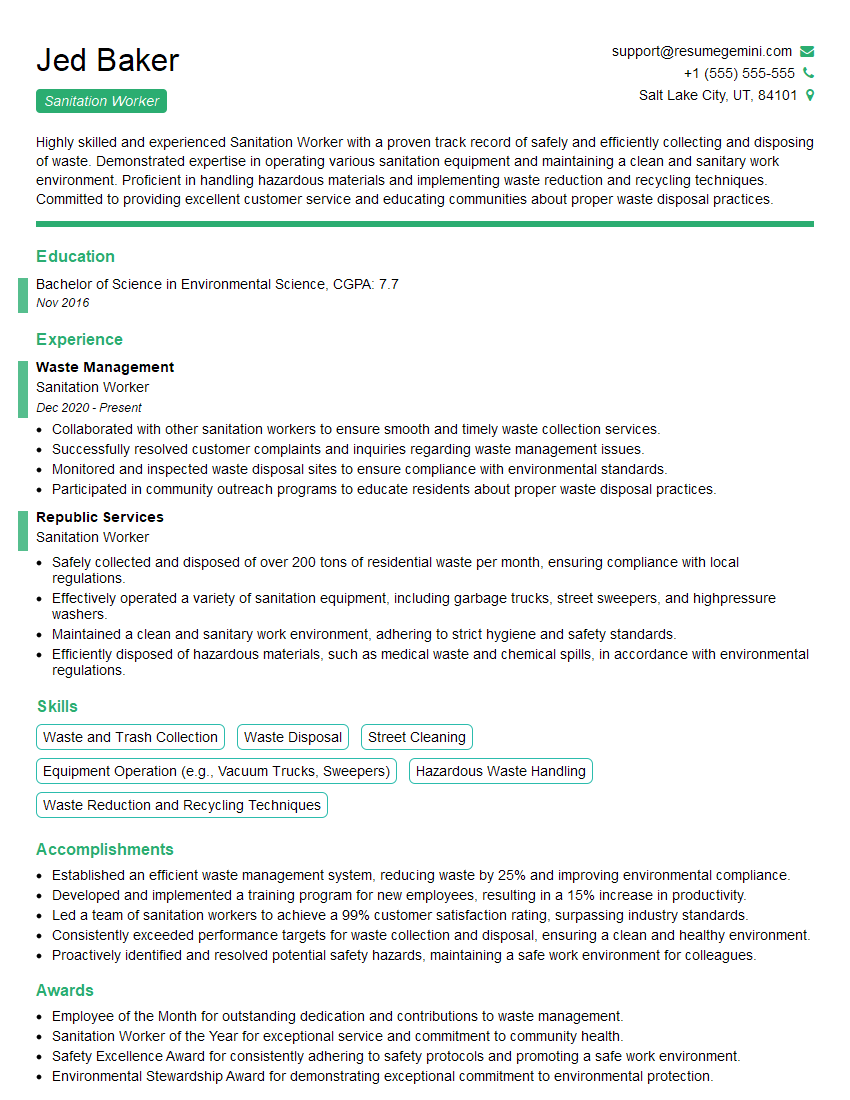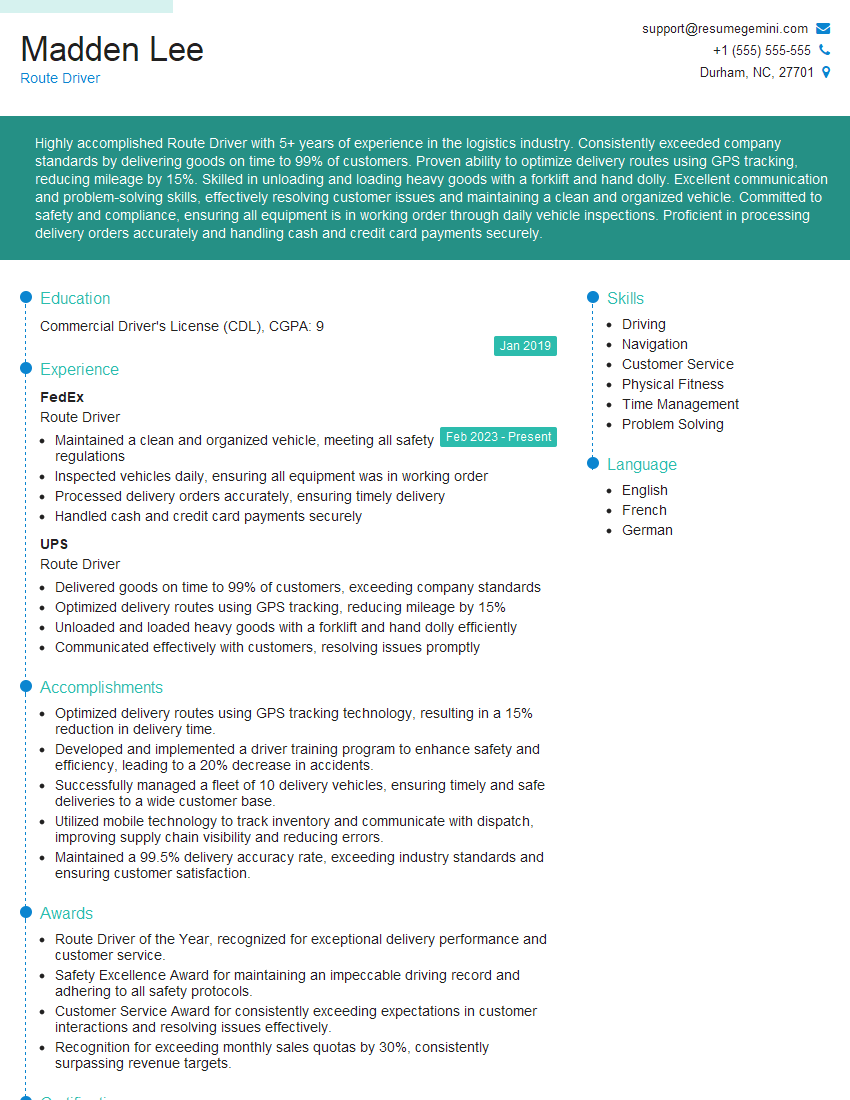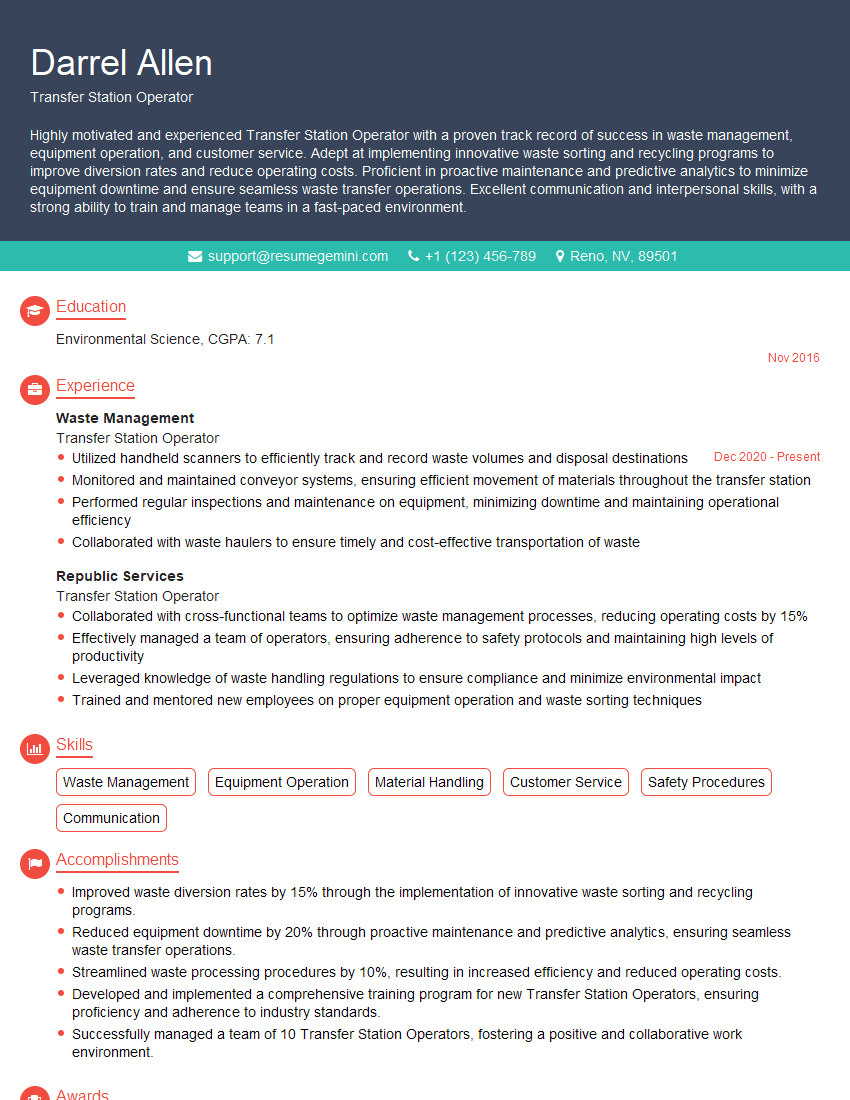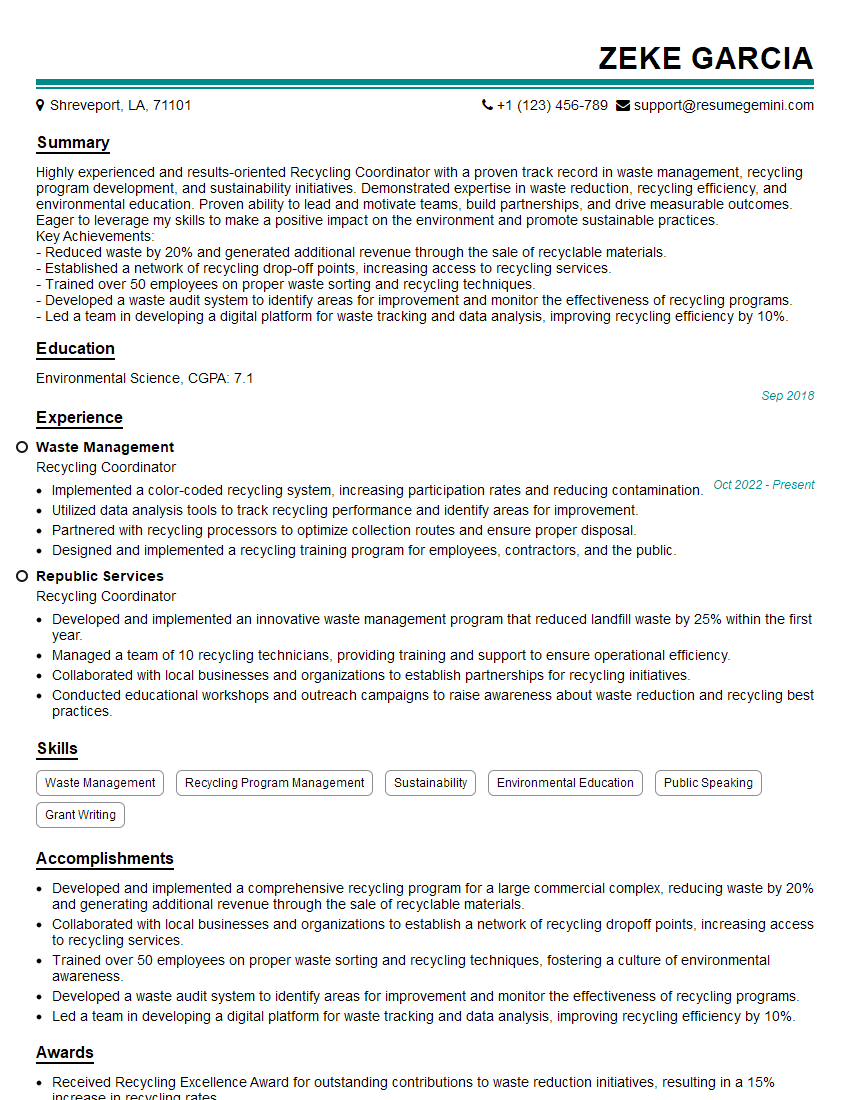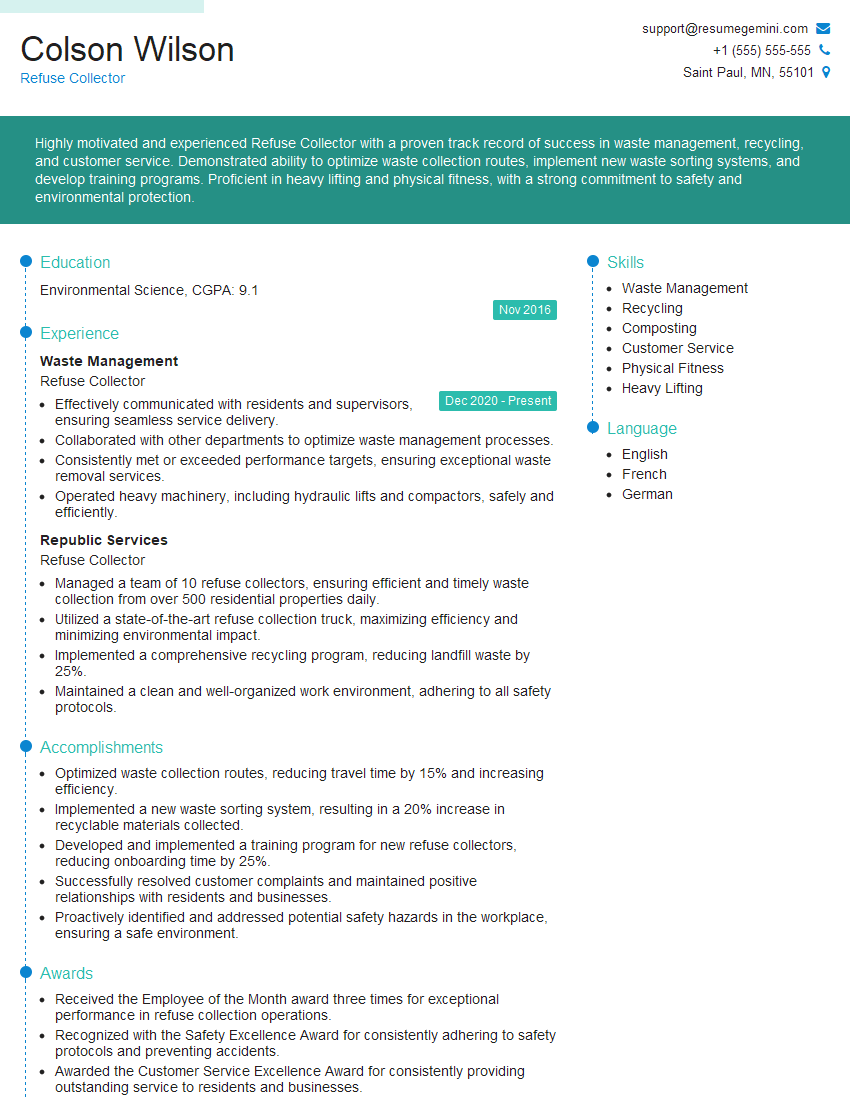Feeling uncertain about what to expect in your upcoming interview? We’ve got you covered! This blog highlights the most important Waste Collection Procedures interview questions and provides actionable advice to help you stand out as the ideal candidate. Let’s pave the way for your success.
Questions Asked in Waste Collection Procedures Interview
Q 1. Describe your experience with different waste collection methods (e.g., curbside, automated, roll-off containers).
My experience encompasses a wide range of waste collection methods, each with its own set of advantages and disadvantages. Curbside collection, the most common method, involves residents placing their waste containers at the curb for collection. This is simple and cost-effective but relies on resident compliance and can be inefficient for high-density areas. Automated systems, using specialized trucks with robotic arms, are significantly faster and more efficient, reducing labor costs and improving safety. However, they require a higher initial investment and may not be suitable for all terrains or waste container types. Finally, roll-off containers are large, dumpsters primarily used for larger-scale waste generation, like construction sites or industrial facilities. These are effective for managing high volumes but require specialized transportation and pose challenges regarding space and access.
For instance, I worked on a project where we transitioned a municipality from curbside to automated collection. The initial investment was significant, but the long-term cost savings due to reduced labor and increased efficiency quickly outweighed the upfront cost. We also had to educate residents on the new system and ensure appropriate container sizes and placement to maximize the benefits.
Another project involved managing roll-off container placement and scheduling for a large-scale construction project. This required detailed planning and coordination to ensure timely removal of waste and minimize disruption to the construction site.
Q 2. Explain your understanding of waste stream segregation and its importance.
Waste stream segregation is the process of sorting waste materials into different categories based on their composition (e.g., recyclables, organics, trash). This is crucial for several reasons. Firstly, it significantly increases the efficiency of recycling and composting programs. Separating materials allows for easier processing and higher-quality end products. Secondly, it minimizes landfill volume and extends their lifespan. Organic waste, for example, can be composted, significantly reducing the amount of material destined for landfills. Finally, it improves environmental protection by reducing pollution and promoting resource conservation.
Imagine a landfill filled entirely with unsorted waste. The valuable recyclable materials are buried, lost to the environment, and the organic material decomposes, generating harmful methane gas. In contrast, a well-segregated waste stream facilitates the recovery of valuable resources and reduces the environmental footprint of waste disposal.
My experience includes designing and implementing waste segregation programs for several communities, focusing on public education and the provision of appropriate sorting infrastructure. For example, we introduced color-coded bins and clear labeling to facilitate easier sorting for residents. We also launched public awareness campaigns, including workshops and online resources, to educate the community about proper segregation practices.
Q 3. How familiar are you with local, state, and federal regulations concerning waste disposal?
I possess a thorough understanding of local, state, and federal regulations concerning waste disposal. My knowledge covers aspects like permitting requirements for waste collection operations, transportation regulations for hazardous waste, and landfill regulations related to leachate and gas management. I’m familiar with the Resource Conservation and Recovery Act (RCRA) at the federal level, and I stay updated on state-specific regulations for waste disposal, recycling, and hazardous waste management.
Local regulations often deal with specific collection schedules, container requirements, and permitted waste types for curbside collection. Compliance requires careful monitoring of these regulations and proactive adaptation to any changes. For instance, I’ve worked on projects requiring amendments to our collection routes to comply with newly implemented local ordinances on specific waste stream handling.
Furthermore, understanding these regulations is vital for ensuring legal and environmentally sound waste management practices, minimizing risks of fines and environmental damage. I regularly attend workshops and training sessions to ensure I stay abreast of any regulatory updates and changes.
Q 4. What are the key performance indicators (KPIs) you would use to measure the efficiency of a waste collection route?
Key Performance Indicators (KPIs) for measuring the efficiency of a waste collection route are crucial for optimizing operations and ensuring cost-effectiveness. Some of the most important KPIs include:
- Collection Time per Stop: This measures the average time spent at each stop, highlighting potential inefficiencies in the route design or collection process.
- Tons Collected per Hour: This indicator demonstrates the productivity of the collection crew and equipment.
- Fuel Consumption per Ton: Monitoring fuel consumption helps optimize routes and identify areas for improvement in fuel efficiency.
- Missed Collection Rate: This tracks the percentage of stops where waste was not collected as scheduled, indicating service quality issues.
- Customer Complaints: This measure provides feedback on the effectiveness and quality of the service provided.
- Driver Safety Record: Accidents and near misses should be tracked to identify safety concerns and implement improvements.
By tracking these KPIs, we can identify areas needing improvement, optimize collection routes, and improve overall efficiency and resource utilization. For example, a high missed collection rate might indicate a need for additional resources or adjustments to the route scheduling.
Q 5. How would you handle a situation where a collection route is significantly behind schedule?
Handling a significantly delayed collection route requires a systematic and immediate response. My approach involves the following steps:
- Assess the Situation: Identify the reasons for the delay (e.g., equipment malfunction, unexpected traffic, increased waste volume).
- Communicate: Inform affected customers about the delay and provide an estimated time of arrival. Transparent communication helps manage expectations and mitigate potential frustration.
- Re-allocate Resources: If possible, redirect resources from other less critical routes to assist the delayed route. This might involve deploying additional trucks or crews.
- Optimize the Route: Analyze the route in real-time using GPS tracking data to identify and eliminate bottlenecks or inefficiencies.
- Implement Contingency Plans: Develop and implement backup plans for situations where delays are unavoidable, like arranging for temporary waste storage solutions.
- Post-Incident Review: After the situation is resolved, conduct a thorough review to identify the root causes of the delay and implement preventive measures to avoid similar situations in the future.
In one instance, a major snowstorm significantly hampered a collection route. By quickly communicating with customers, deploying additional snow-removal equipment, and re-routing vehicles, we successfully managed the situation while minimizing disruption.
Q 6. Describe your experience with GPS tracking and route optimization software.
I have extensive experience with GPS tracking and route optimization software. These technologies are essential for enhancing efficiency, improving service quality, and reducing operational costs. GPS tracking provides real-time location data for collection vehicles, enabling better monitoring of route progress, identification of potential delays, and improved communication with drivers. Route optimization software uses algorithms to analyze various factors like traffic patterns, distance, and service demands to design efficient collection routes, minimizing travel time and fuel consumption.
For example, I utilized a route optimization software that integrated real-time traffic data to dynamically adjust routes during peak traffic hours, reducing delays and improving on-time performance. We also used the GPS tracking data to analyze driver behavior and identify areas where training could improve efficiency and safety.
Example Data Point: {vehicleID: 'Truck123', latitude: 34.0522, longitude: -118.2437, timestamp: '2024-10-27T10:30:00Z', status: 'En route'}
This kind of data is fed into the optimization software to improve future routing.
Q 7. Explain your experience with hazardous waste handling procedures and safety protocols.
Handling hazardous waste requires strict adherence to safety protocols and regulatory compliance. My experience includes managing the collection, transportation, and disposal of various hazardous waste materials, following all applicable regulations (like RCRA). This involves understanding the specific hazards associated with each waste type, selecting appropriate containment and transportation methods, and ensuring proper labeling and documentation. Proper training for personnel handling hazardous waste is paramount.
Safety protocols are crucial. This includes the use of personal protective equipment (PPE), such as respirators, gloves, and protective clothing, and adherence to strict procedures for handling and transporting hazardous materials. Emergency response plans are essential, in case of spills or other incidents. Detailed record-keeping is also vital, including manifests tracking the movement of hazardous waste from origin to disposal.
For example, I’ve overseen the implementation of a hazardous waste management program for a manufacturing facility, requiring detailed risk assessment, proper segregation of hazardous materials, the training of personnel, and the engagement of licensed hazardous waste transporters to ensure safe and legal disposal. We also conducted regular safety audits to identify potential risks and enforce best practices.
Q 8. How would you address a complaint from a resident regarding missed collection or overflowing bins?
Addressing a missed collection or overflowing bin complaint begins with empathy and prompt action. I’d first acknowledge the resident’s frustration and assure them I’m taking their concern seriously. Then, I’d follow a systematic approach:
- Verification: I’d check our collection routes and schedules to confirm if a genuine miss occurred or if there was a justifiable reason (e.g., road closure, unforeseen circumstances). Our GPS tracking data on collection vehicles would be invaluable here.
- Investigation: If a miss is confirmed, I’d investigate further. Was the bin properly placed? Were there any obstructions? Were there any issues with the bin itself (e.g., damage preventing lifting)?
- Resolution: Depending on the cause, the solution might involve immediate collection, a follow-up visit, providing a replacement bin, or addressing issues with bin placement guidelines with the resident.
- Communication: I’d keep the resident updated throughout the process, providing estimated timeframes for resolution. A follow-up call or email after the issue is resolved ensures customer satisfaction.
For example, if a bin was missed due to an unforeseen blockage, I would explain the situation to the resident and schedule a special pick-up as soon as possible. If the bin was overflowing due to incorrect waste sorting, I would educate the resident on proper disposal guidelines and potentially offer assistance with separating the waste.
Q 9. What is your understanding of waste reduction strategies and their implementation?
Waste reduction strategies are crucial for environmental sustainability and efficient waste management. My understanding encompasses a multi-pronged approach:
- Source Reduction: This involves minimizing waste generation at its source. Examples include promoting reusable bags, encouraging businesses to reduce packaging, and implementing composting programs.
- Recycling and Composting: Diverting recyclable and compostable materials from landfills extends the lifespan of landfills and conserves resources. Effective implementation requires clear public education campaigns, accessible recycling facilities, and robust collection systems that separate different materials.
- Waste-to-Energy: In some cases, non-recyclable waste can be processed to generate energy, reducing reliance on fossil fuels. However, careful consideration of environmental impacts, like air emissions, is vital.
- Public Awareness Campaigns: Educating the public about proper waste disposal, the importance of reducing waste, and the benefits of recycling and composting is crucial for successful implementation of any waste reduction strategy. Using social media, community events, and educational materials helps increase engagement and participation.
For instance, I’ve been involved in implementing a successful curbside composting program that significantly reduced the amount of organic waste sent to landfills. We combined convenient collection services with a targeted educational campaign and saw a substantial increase in participation.
Q 10. How would you manage a team of waste collection workers?
Managing a team of waste collection workers requires a blend of leadership, communication, and safety protocols. My approach would focus on:
- Clear Communication: Regular team meetings, clear task assignments, and open channels for feedback create a positive work environment and ensure everyone is informed and on the same page.
- Safety Training and Enforcement: Prioritizing safety is paramount. This includes thorough training on safe lifting techniques, equipment operation, and hazard awareness, and consistent enforcement of safety regulations. Regular safety checks and refresher courses are crucial.
- Motivation and Recognition: Recognizing and rewarding good performance builds morale and encourages teamwork. Celebrating milestones and providing opportunities for professional development fosters employee loyalty and productivity.
- Performance Management: Regular performance reviews and constructive feedback help identify areas for improvement and address any performance issues promptly and fairly.
- Problem-Solving and Teamwork: Encouraging a collaborative environment where workers can share ideas and collectively solve problems is essential for efficiency and morale.
For example, I’ve successfully implemented a peer-to-peer safety observation program where team members regularly check each other’s work practices, leading to a significant reduction in workplace accidents.
Q 11. Describe your experience with vehicle maintenance and safety inspections.
My experience includes regular vehicle maintenance and safety inspections following all relevant guidelines and regulations. This involves:
- Pre-Trip Inspections: Daily checks before each route to ensure vehicles are in safe operating condition, including tire pressure, fluid levels, lights, and brakes.
- Scheduled Maintenance: Adhering to a strict maintenance schedule for oil changes, filter replacements, and other necessary repairs to prevent breakdowns and ensure longevity of vehicles. This includes keeping detailed records of all maintenance activities.
- Safety Inspections: Regular inspections to check for any mechanical issues that could compromise safety, and addressing identified problems immediately. This often involves working closely with mechanics to address any required repairs.
- Documentation: Maintaining comprehensive records of all maintenance and inspections to comply with regulations and ensure traceability.
In a previous role, I implemented a preventative maintenance program that reduced vehicle downtime by 15% and improved overall fleet efficiency.
Q 12. What are the common types of waste collected and how are they processed?
Common types of waste collected vary by region and local regulations, but generally include:
- Residential Waste: This includes everyday household garbage like food scraps, packaging, and general trash.
- Recyclable Materials: These are materials that can be processed and reused, such as paper, plastic, glass, and metal. The specific materials accepted vary depending on local recycling programs.
- Yard Waste: This includes grass clippings, leaves, and other organic material from landscaping.
- Hazardous Waste: This includes items like paints, batteries, and chemicals that require special handling and disposal due to their potential environmental hazards.
- Construction and Demolition Debris: This often involves larger items and requires different processing techniques compared to household waste.
Processing involves different methods depending on the waste type. Residential waste typically goes to landfills or waste-to-energy facilities. Recyclables are sorted and processed for reuse. Yard waste is often composted, while hazardous waste undergoes specialized treatment and disposal to prevent environmental contamination.
Q 13. How would you handle a situation where a waste container is damaged or overflowing?
Handling damaged or overflowing containers requires a swift and safe response:
- Assessment: Determine the extent of the damage and the reason for overflowing. Is it due to damage, incorrect waste sorting, or insufficient bin size for the household?
- Safety First: If there’s a risk of injury (e.g., sharp objects, hazardous materials), cordon off the area and contact the appropriate personnel (e.g., safety officer, hazardous waste team).
- Immediate Action: If it’s simply overflowing, arrange for an immediate collection. If the bin is damaged, arrange for replacement and ensure the contents are safely transferred to a temporary replacement bin.
- Investigation: If the overflowing is due to incorrect sorting, educate the resident about proper waste disposal. If it’s due to insufficient bin size, consider offering a larger bin or exploring alternative waste disposal options.
- Documentation: Record the incident, actions taken, and the resolution for future reference.
For instance, a damaged bin might be repaired or replaced, and I would ensure the resident has a suitable alternative until the repair or replacement is completed.
Q 14. Explain your experience with waste transfer stations and landfills.
My experience encompasses the entire waste stream, including waste transfer stations and landfills.
- Waste Transfer Stations: These act as intermediary points where waste collected from smaller vehicles is consolidated into larger vehicles for transport to landfills or other processing facilities. My role involved overseeing the efficient flow of waste through the station, ensuring proper sorting and safety protocols are maintained.
- Landfills: I’m familiar with landfill operations, including waste compaction, leachate management, and gas collection systems. Understanding landfill regulations and environmental considerations is crucial to ensure responsible waste disposal.
For example, I’ve worked to optimize waste transfer station operations by improving vehicle routing and scheduling, resulting in reduced transportation costs and improved efficiency. I’ve also been involved in projects aimed at improving landfill gas capture and utilization, reducing greenhouse gas emissions.
Q 15. Describe your experience with recycling and composting programs.
My experience with recycling and composting programs is extensive, encompassing both residential and commercial sectors. I’ve worked with municipalities to implement curbside recycling programs, including public education campaigns to increase participation and reduce contamination. This involved designing clear labeling systems for bins, creating educational materials, and organizing community events to promote best practices. In the commercial sector, I’ve assisted businesses in setting up comprehensive waste diversion programs, optimizing their waste streams for maximum recycling and composting. This often involves on-site audits to identify opportunities for improvement, training staff on proper sorting techniques, and negotiating contracts with recycling and composting facilities. For example, one successful project involved a large office complex where we managed to increase their recycling rate from 20% to 65% within six months by implementing a tailored education plan and improving their sorting infrastructure.
- Residential Programs: Designing efficient curbside collection routes, optimizing bin sizes, and managing public communication.
- Commercial Programs: Conducting waste audits, implementing customized waste reduction strategies, and negotiating contracts with processing facilities.
Career Expert Tips:
- Ace those interviews! Prepare effectively by reviewing the Top 50 Most Common Interview Questions on ResumeGemini.
- Navigate your job search with confidence! Explore a wide range of Career Tips on ResumeGemini. Learn about common challenges and recommendations to overcome them.
- Craft the perfect resume! Master the Art of Resume Writing with ResumeGemini’s guide. Showcase your unique qualifications and achievements effectively.
- Don’t miss out on holiday savings! Build your dream resume with ResumeGemini’s ATS optimized templates.
Q 16. How do you ensure compliance with safety regulations during waste collection operations?
Ensuring compliance with safety regulations during waste collection is paramount. Our operations adhere strictly to OSHA (Occupational Safety and Health Administration) guidelines and any relevant local regulations. This includes comprehensive driver training that covers safe driving practices, proper lifting techniques, and hazard awareness (e.g., sharp objects, hazardous materials). Regular vehicle maintenance checks are crucial, preventing mechanical failures that could lead to accidents. We equip our drivers with personal protective equipment (PPE), including high-visibility vests, gloves, safety boots, and sometimes respirators, depending on the waste type. We also conduct regular safety meetings and provide ongoing training to address any new risks or challenges. For instance, we use GPS tracking systems to monitor driver behavior and ensure adherence to speed limits and safe route navigation. We also conduct detailed incident reporting and analysis to identify areas for improvement in our safety procedures. This data-driven approach allows us to proactively address potential hazards and prevent future incidents.
Q 17. What is your understanding of the environmental impact of improper waste disposal?
Improper waste disposal has significant environmental consequences. Landfills, when not managed properly, generate greenhouse gases like methane, a potent contributor to climate change. Leachate, a contaminated liquid produced by decomposing waste, can pollute groundwater sources, impacting drinking water supplies and ecosystems. Improper disposal of hazardous waste poses serious threats to human health and the environment, causing soil and water contamination, and potentially leading to air pollution. Improperly disposed plastics end up in oceans and waterways, harming marine life through entanglement and ingestion. Litter from improper disposal degrades the aesthetic value of our communities and negatively impacts biodiversity. For example, a single plastic bag takes hundreds of years to decompose, posing a persistent threat to wildlife.
Q 18. Describe your experience with waste collection route planning and scheduling.
Waste collection route planning and scheduling are crucial for efficiency and cost-effectiveness. My experience involves using route optimization software to design efficient collection routes, considering factors like traffic patterns, terrain, and the number of service points. We utilize GPS tracking to monitor vehicle location in real-time, enabling dynamic adjustments to routes based on unforeseen circumstances like traffic congestion or unexpected delays. Scheduling involves coordinating collection times with customer needs and optimizing vehicle capacity to minimize the number of trips required. We frequently analyze route data to identify bottlenecks and inefficiencies, making necessary adjustments to maximize productivity. For example, a recent project involved implementing a new scheduling algorithm that reduced our overall route mileage by 15%, leading to significant fuel savings and reduced emissions.
Q 19. How familiar are you with different types of waste collection vehicles?
I am familiar with a range of waste collection vehicles, each suited for different types of waste and operational needs. These include:
- Rear-loading trucks: Commonly used for residential and commercial waste collection, with a hopper at the rear for loading.
- Side-loading trucks: More efficient for high-density areas, with loading mechanisms on the side.
- Roll-off containers: Large, open-top containers used for bulk waste collection, often requiring specialized trucks for transport.
- Automated side loaders (ASLs): Used in high-volume areas, automatically lifting and emptying standardized containers.
- Specialized vehicles for hazardous waste: These are designed to safely transport and contain hazardous materials, complying with strict regulations.
The choice of vehicle depends on factors such as waste volume, container type, road accessibility, and operational efficiency requirements.
Q 20. How would you handle an emergency situation involving a waste collection vehicle?
Handling an emergency involving a waste collection vehicle requires a swift and organized response. Our protocols include immediate notification of emergency services (police, fire, ambulance, if needed) and the implementation of a crisis management plan. This plan outlines procedures for securing the scene, ensuring the safety of personnel and the public, and managing potential environmental risks. We also have established communication channels to inform relevant stakeholders and the public, as necessary. For example, if a vehicle malfunctions causing a spill, our emergency plan includes containment procedures to prevent further environmental damage and the immediate initiation of cleanup efforts by our trained personnel.
Q 21. What are the different types of waste containers used in waste collection?
Waste collection utilizes diverse containers depending on the type of waste and collection method. Common examples include:
- Residential bins: Typically wheeled bins (ranging in size) for household garbage, recycling, and sometimes composting.
- Commercial dumpsters: Large, stationary containers for businesses and institutions, ranging from small to extremely large sizes.
- Specialized containers for hazardous waste: These are designed for specific waste types, often color-coded and labeled for easy identification and safe handling.
- Roll-off containers: Large containers for bulk waste, construction debris, or demolition materials.
- Recycling bins (various): Specific containers for different materials such as paper, plastic, glass, and metal.
The selection of containers is based on factors such as waste volume, waste type, ease of handling, and regulatory requirements.
Q 22. What strategies would you employ to reduce waste generation?
Reducing waste generation requires a multi-pronged approach focusing on prevention, reduction, and reuse. It’s not just about collection, but about changing behaviors upstream.
- Source Reduction: This involves designing products with less packaging, encouraging businesses to adopt sustainable practices (like reusable containers instead of single-use plastics), and promoting the purchase of durable, repairable goods. For example, a city could incentivize businesses to reduce packaging through tax breaks or public recognition.
- Reuse and Repurposing: Encouraging residents to reuse items creatively, repair goods instead of discarding them, and participate in community initiatives like clothing swaps or tool libraries significantly reduces landfill waste. Think of community composting programs, where organic waste is diverted from landfills and transformed into valuable soil amendment.
- Recycling and Composting Programs: Effective and accessible recycling and composting programs are crucial. This includes clear labeling, convenient drop-off locations, and public education campaigns that explain what can and cannot be recycled/composted. A successful program might involve color-coded bins and regular educational workshops for residents.
- Public Awareness Campaigns: Educating the public about the environmental and economic impacts of waste generation through targeted campaigns – possibly in partnership with local schools and community groups – is essential. Think of interactive workshops or social media campaigns showcasing the benefits of waste reduction.
Implementing these strategies requires collaboration with stakeholders across the community, from residents and businesses to local government and environmental organizations. It’s about building a culture of responsibility and sustainability.
Q 23. How do you ensure the accuracy of waste collection data?
Ensuring accurate waste collection data is critical for efficient operations and informed decision-making. It relies on a combination of robust data collection methods and verification processes.
- GPS Tracking of Collection Vehicles: Real-time GPS tracking provides accurate records of routes, stops, and the time spent at each location. This helps verify that all scheduled pickups occurred and flags any anomalies, like unexpectedly long stops.
- Smart Bins with Sensors: Smart bins equipped with sensors provide real-time data on fill levels, allowing for optimized collection schedules. This minimizes unnecessary trips and ensures that bins aren’t overflowing.
- Manual Data Entry Verification: While technology aids in data accuracy, human oversight is crucial. Data from GPS and sensors should be cross-checked with manual records entered by drivers or collection crews. This helps identify and address any discrepancies.
- Regular Audits and Data Reconciliation: Conducting regular audits of waste collection data, comparing it against anticipated volumes based on population density and waste generation patterns, is crucial for identifying potential issues and discrepancies. This process helps fine-tune collection routes and resource allocation.
- Data Analysis and Reporting: Utilizing data analytics tools to identify trends, patterns, and anomalies in waste generation and collection helps refine strategies, improving efficiency and reducing operational costs.
By combining technological advancements with human oversight and rigorous data analysis, we can significantly improve the accuracy and reliability of waste collection data.
Q 24. Describe your experience with using waste management software.
I have extensive experience using waste management software, including route optimization software, and data management systems. In my previous role, we implemented a system that integrated GPS tracking with a customer relationship management (CRM) system. This allowed us to:
- Optimize collection routes: The software analyzed factors such as traffic patterns, distance, and fill levels to create the most efficient routes for our collection vehicles, reducing fuel consumption and labor costs.
- Improve customer service: The CRM system integrated with the waste management software allowed us to track customer requests, complaints, and service history, providing better customer service and quicker response times to issues.
- Generate comprehensive reports: The system generated detailed reports on various metrics, including collection volumes, fuel consumption, and labor costs. This data was vital in our budget planning and performance evaluation.
- Enhance data analysis capabilities: The software’s data analysis features allowed us to identify trends and patterns in waste generation, informing our strategies for waste reduction and resource allocation.
My experience with these systems has enabled me to significantly improve operational efficiency, reduce costs, and enhance customer satisfaction.
Q 25. How familiar are you with waste auditing procedures?
I am very familiar with waste auditing procedures. Waste audits are a crucial tool for assessing the effectiveness of waste management programs and identifying opportunities for improvement.
- Pre-audit planning: This involves defining the scope of the audit, identifying the data sources, and establishing the audit methodology. It’s critical to know what we’re looking for and how we’ll measure it.
- Data Collection: This might involve reviewing waste composition data, analyzing collection records, and conducting on-site waste stream observations (e.g., visually inspecting waste bins). Detailed records are essential.
- Data Analysis: Once the data is gathered, it’s analyzed to determine the composition of the waste stream, identify areas where waste reduction and diversion strategies could be implemented, and assess compliance with regulations.
- Reporting and Recommendations: The audit findings are documented in a report that includes key findings, conclusions, and recommendations for improvement. The report might suggest changes to collection strategies, public education campaigns, or material recovery programs.
For example, in a previous audit, we discovered that a significant portion of recyclable materials were ending up in the landfill due to contamination. This led to changes in the public education program emphasizing proper sorting techniques, resulting in a measurable increase in recycling rates.
Q 26. Describe your experience with employee training and safety procedures.
Employee training and safety are paramount in waste collection. It’s not just about following procedures; it’s about fostering a culture of safety and continuous improvement.
- Comprehensive Training Programs: New employees receive thorough training on safe operating procedures for collection vehicles, handling hazardous materials, and interacting with the public. This includes both theoretical and practical components.
- Regular Safety Refresher Courses: Experienced employees participate in regular safety refresher courses to reinforce best practices and address any changes in regulations or procedures. This keeps safety top of mind.
- Use of Personal Protective Equipment (PPE): Providing and enforcing the use of appropriate PPE, such as gloves, safety boots, and high-visibility clothing, is vital to minimizing workplace risks. We conduct regular inspections to ensure that everything is working correctly and in good condition.
- Incident Reporting and Investigation: A clear protocol for reporting and investigating incidents is critical to identifying the root causes of accidents and implementing corrective actions. We conduct thorough investigations and use the information to improve safety measures.
- Ergonomic Considerations: Training incorporates ergonomic principles to minimize the risk of musculoskeletal injuries. This includes using proper lifting techniques, using equipment that minimizes strain, and taking regular breaks.
By prioritizing employee training and safety, we not only protect our workforce but also improve operational efficiency and reduce the risk of accidents and injuries.
Q 27. How would you manage conflicts between residents and waste collection crews?
Conflict resolution is a key skill in waste management. Handling conflicts between residents and collection crews requires a calm, professional, and empathetic approach.
- Establish Clear Communication Channels: Provide multiple avenues for residents to report issues, such as a dedicated phone line, online portal, or email address. Prompt response is essential.
- On-site Conflict Resolution: Crews should be trained to handle minor conflicts professionally and politely. This might involve explaining procedures, addressing concerns, or offering alternative solutions.
- Escalation Procedures: For more serious conflicts, a clear escalation procedure should be in place. This might involve referring the issue to a supervisor or a designated conflict resolution specialist.
- Regular Community Engagement: Proactive communication with residents through community meetings, newsletters, or social media can prevent conflicts by addressing concerns before they escalate. Open dialogue is important.
- Documentation and Follow-up: Meticulously document all conflicts and the steps taken to resolve them. Follow up with residents to ensure their concerns have been addressed and to gauge their satisfaction.
A proactive and responsive approach to conflict resolution builds trust and fosters positive relationships between residents and waste collection crews.
Q 28. What are your salary expectations?
My salary expectations are commensurate with my experience and skills in the field of waste collection and management. I am confident that my expertise in optimizing routes, managing data, and ensuring safe and efficient operations will bring significant value to your organization. I am open to discussing a competitive salary range based on the specific details of the position and the overall compensation package.
Key Topics to Learn for Waste Collection Procedures Interview
- Route Optimization and Planning: Understanding factors influencing efficient waste collection routes (traffic patterns, geographical constraints, service frequency). Practical application: Analyzing a given route map to identify potential improvements in efficiency and time management.
- Waste Stream Management: Differentiating between various waste types (residential, commercial, industrial, hazardous), their handling, and disposal methods. Practical application: Describing the appropriate procedure for handling a specific type of waste encountered on a collection route.
- Health and Safety Regulations: Knowledge of relevant OSHA or equivalent safety regulations and procedures for operating collection vehicles and handling waste materials. Practical application: Explaining safe practices to prevent injuries or accidents during waste collection.
- Equipment Operation and Maintenance: Familiarity with the operation and basic maintenance of waste collection vehicles and equipment (e.g., compactors, lift arms). Practical application: Troubleshooting minor equipment malfunctions and describing preventative maintenance procedures.
- Customer Service and Communication: Effective communication with residents and businesses regarding waste collection schedules, regulations, and resolving service issues. Practical application: Describing your approach to handling a customer complaint or addressing a missed collection.
- Waste Reduction and Recycling Programs: Understanding the principles of waste reduction and the role of waste collection in supporting recycling and sustainability initiatives. Practical application: Explaining how to promote recycling participation within a community.
- Waste Disposal Regulations and Compliance: Understanding local, regional, and national regulations related to waste disposal and environmental protection. Practical application: Describing the proper procedures for handling a spill or accidental release of hazardous waste.
Next Steps
Mastering Waste Collection Procedures is crucial for career advancement in this growing field. Demonstrating a comprehensive understanding of these procedures is key to securing your dream position. To significantly enhance your job prospects, creating a strong, ATS-friendly resume is essential. ResumeGemini is a trusted resource that can help you build a professional and impactful resume tailored to highlight your skills and experience. Examples of resumes tailored to Waste Collection Procedures are available, helping you present yourself effectively to potential employers.
Explore more articles
Users Rating of Our Blogs
Share Your Experience
We value your feedback! Please rate our content and share your thoughts (optional).
What Readers Say About Our Blog
Hi, I represent an SEO company that specialises in getting you AI citations and higher rankings on Google. I’d like to offer you a 100% free SEO audit for your website. Would you be interested?
good
